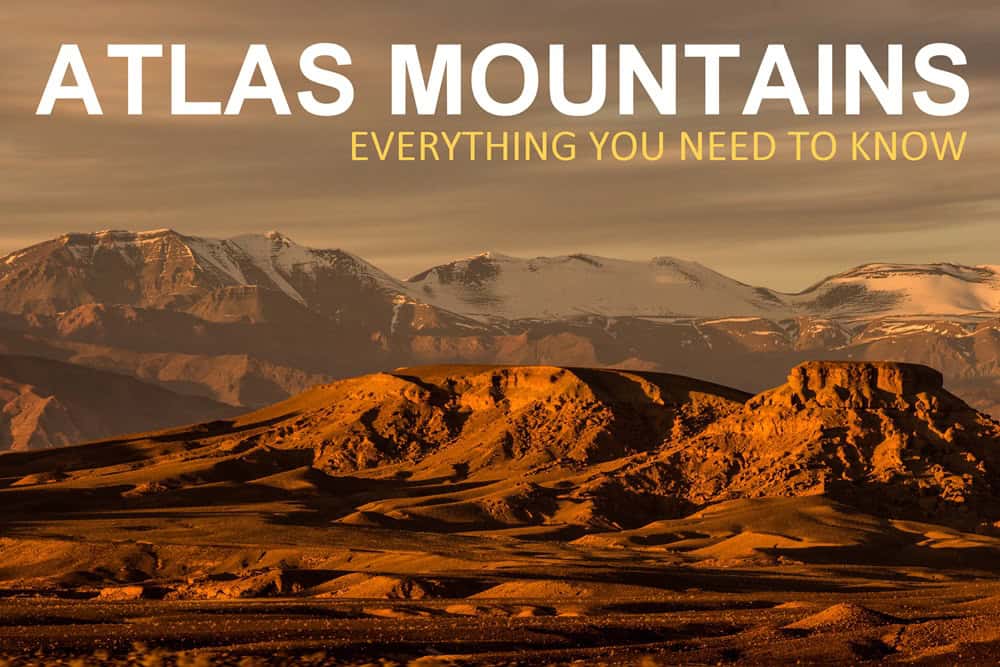
Where are the Atlas Mountains?
The Atlas Mountains are located in Northern Africa. The range forms a natural barrier between the Sahara Desert and the coast. It is also a natural boundary between the Mediterranean and Atlantic coastlines
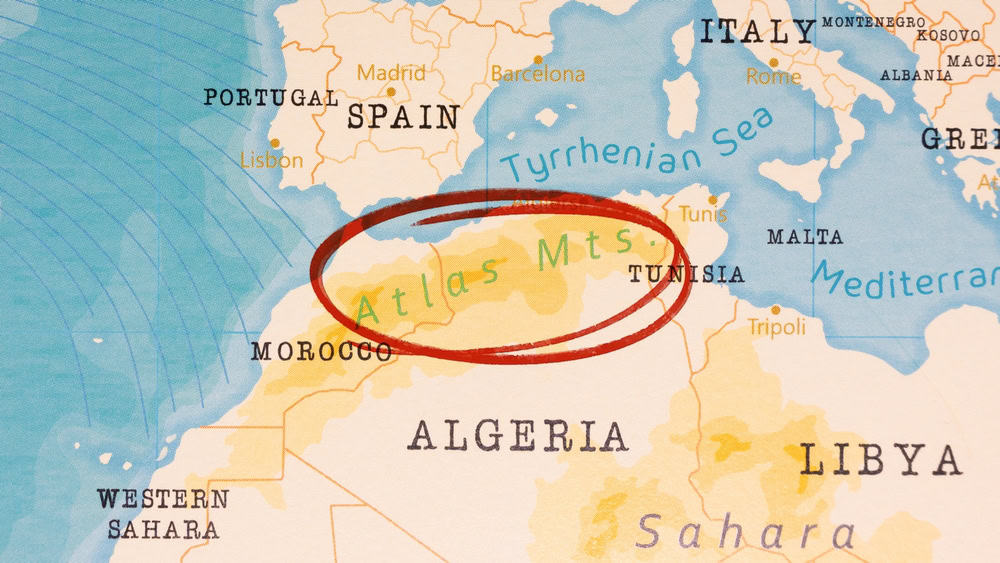
How Long are the Atlas Mountains?
The Atlas Mountains are one of Africa’s most extensive mountain systems, covering 1,553 miles (2,500 kilometers).
What Countries are the Atlas Mountains in?
The Atlas Mountains run through the heart of Morocco, Algeria, and Tunisia. Each country claims its unique stretch of the mountain range.
There are four distinct sections of the Atlas Mountains:
- Anti-Atlas, High Atlas, and Middle Atlas (Morocco)
- Tell Atlas (Morocco, Algeria, Tunisia)
- Aurès Mountains (Algeria, Tunisia)
- Saharan Atlas (Algeria)
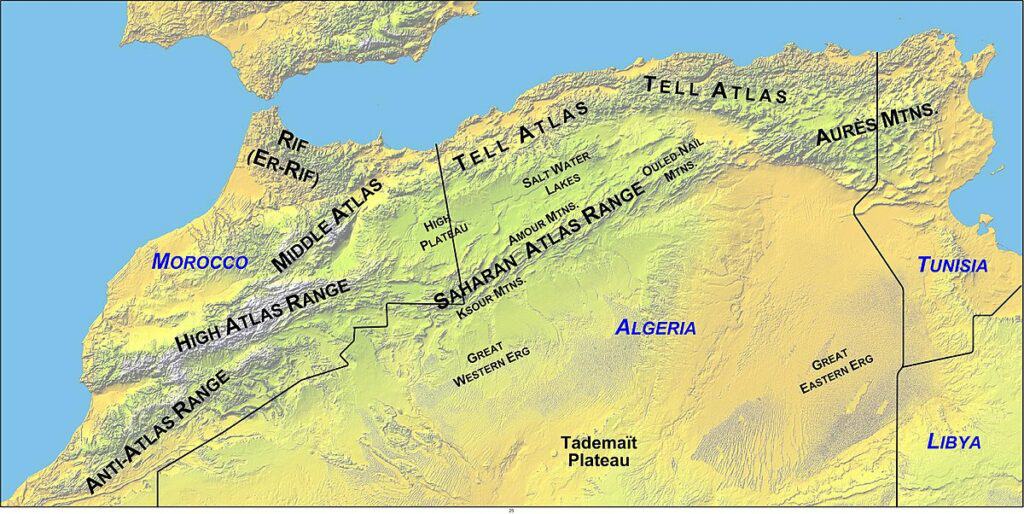
Anti-Atlas, High Atlas, and Middle Atlas
The Anti-Atlas range, also known as the Lesser Atlas, lies in southern Morocco. Stretching over 300 miles (483 km), this range is characterised by its barren landscapes, rugged terrain and arid climate. Unlike its counterparts, the Anti-Atlas is sparsely populated with nomadic tribes and isolated villages. It is known for its unique geological formations and rich mineral deposits, particularly silver and cobalt.
The High Atlas is the tallest of the Atlas ranges. It runs diagonally across central Morocco for about 460 miles (740 km) from the Atlantic coast to the Moroccan-Algerian border. This range includes North Africa’s highest peak, Mount Toubkal. The High Atlas serves as a climatic barrier, creating distinct weather patterns on either side.
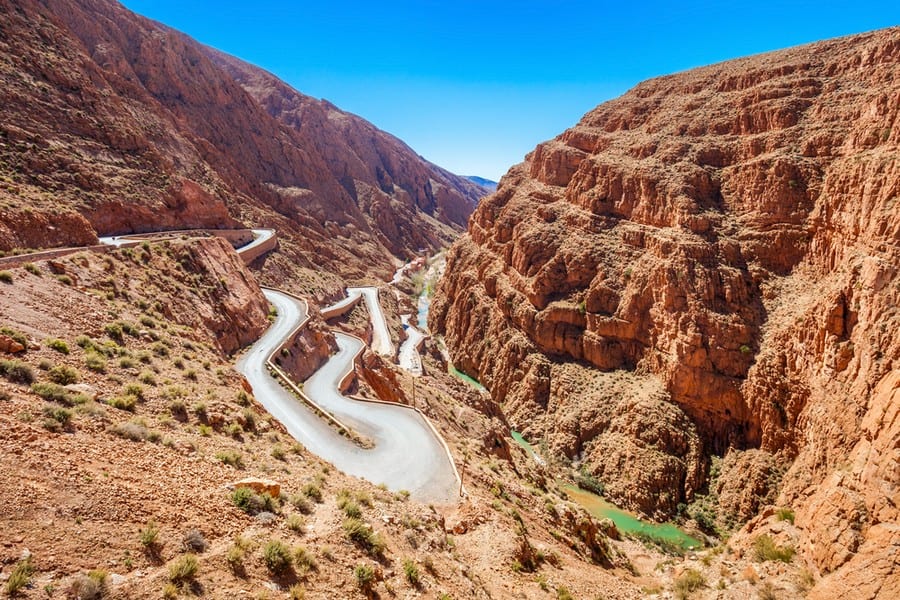
Situated between the High Atlas and the Rif Mountains, the Middle Atlas extends over 220 miles (350 km). It is characterized by its more moderate elevations. This region is a natural buffer between the arid plains to the south and the fertile coastal regions to the north. It receives a relatively higher rainfall compared to other Atlas ranges.
Tell Atlas
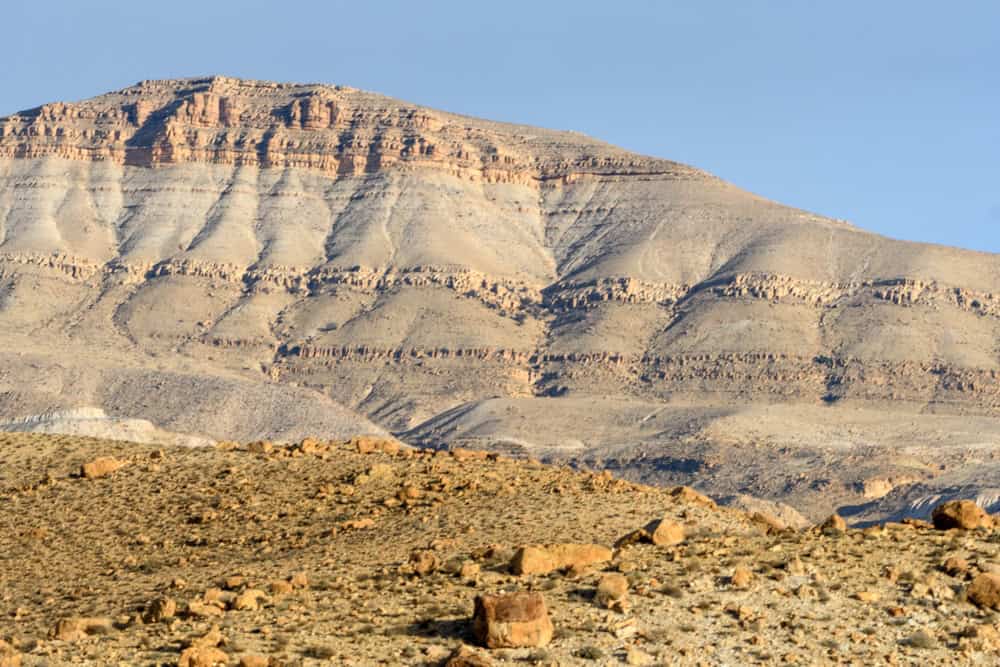
The Tell Atlas Range runs approximately 932 miles (1,500 kilometers) from the Moroccan border, through Algeria’s northern landscape and extending into Tunisia. The Tell Atlas is known for several high peaks, with the highest being Lalla Khedidja.
Aurès Mountains
The Aurès Mountains stretch over 310 miles (500 kilometers) from northeastern Algeria to the Tunisian border. These mountains have been a historical stronghold of the Berber Chaoui people, who maintain their traditional way of life. The region played a significant role in the Algerian War of Independence, serving as a base against colonial powers and foreign invasions. The area is rich in archaeological sites, including ancient Roman ruins and Berber fortresses.
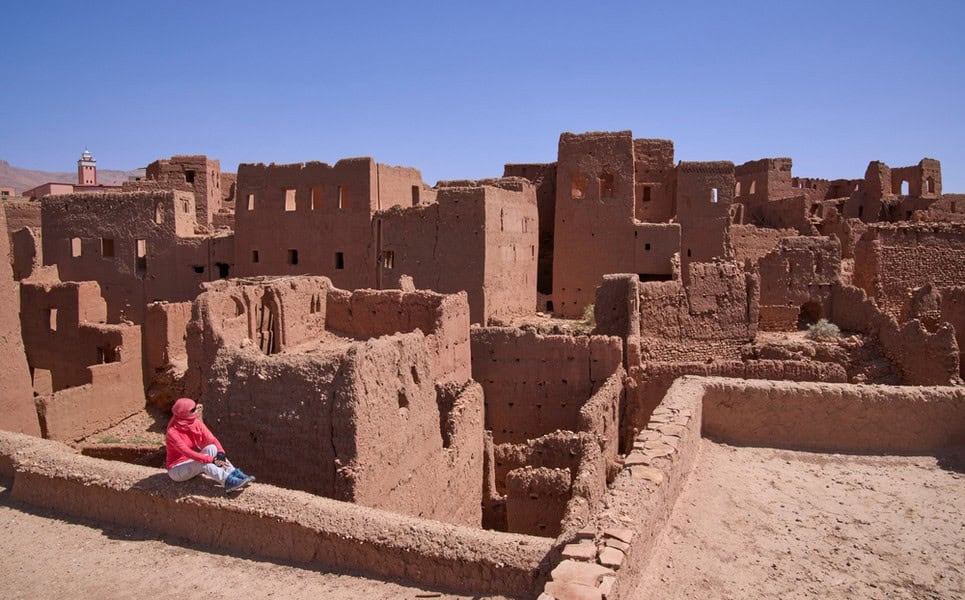
Saharan Atlas
The Saharan Atlas is located on the northernmost edge of the Sahara Desert in Algeria. It serves as a transitional zone between the Mediterranean climate of the north and the arid Sahara to the south. It spans approximately 932 miles (1,500 kilometers).
Where Do the Atlas Mountains Start and End?
This mighty range begins near the Atlantic Coast in Morocco. It winds eastward through Algeria and Tunisia, ending near the Mediterranean Sea.
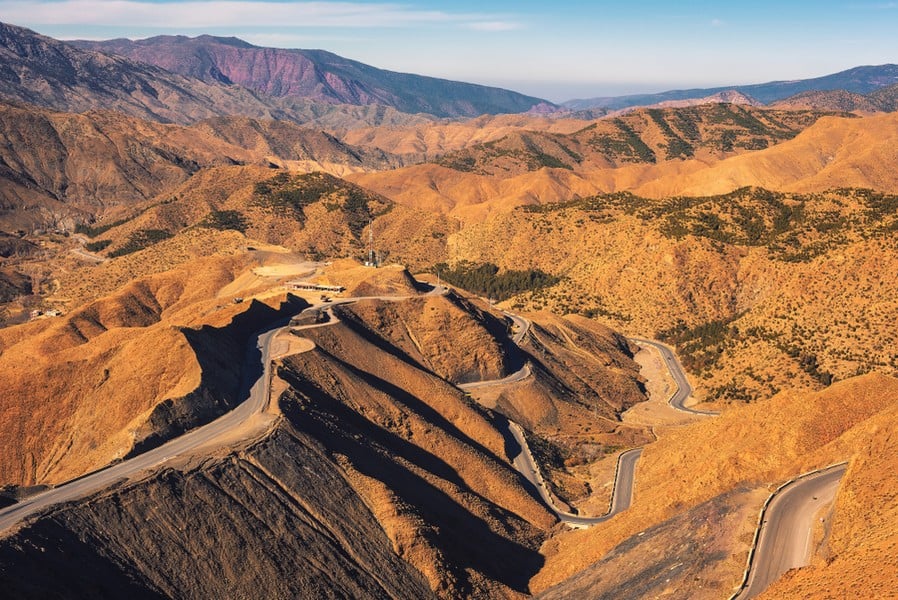
How Did the Atlas Mountains Form?
The formation of the Atlas Mountains is rooted in the dynamic processes of plate tectonics. They emerged due to the collision of two major tectonic plates: the African and Eurasian plates.
Approximately 65 to 50 million years ago, the northern edge of the African Plate began to collide with the southern edge of the Eurasian Plate. This collision initiated a process known as continental collision or orogenesis. The edges of the two plates crumpled and folded, giving rise to the Atlas Mountain range.
In addition to compressional forces, weathering and glaciation have influenced the Atlas Mountains. Valleys, gorges, and peaks were carved into the landscape over millions of years. Rivers and streams flowing from the mountains further sculpted the terrain, creating deep valleys and fertile plains.
Why are They Called the Atlas Mountains?

The Atlas Mountains are named after Atlas from Greek mythology. Atlas was a Titan condemned by Zeus to hold up the sky for eternity. This punishment was a consequence of Atlas’s role in the war between the Titans and the Olympian gods. The name Atlas symbolizes strength and endurance, which are represented by the imposing nature of the Atlas Mountains.
How Big and Tall are the Atlas Mountains?
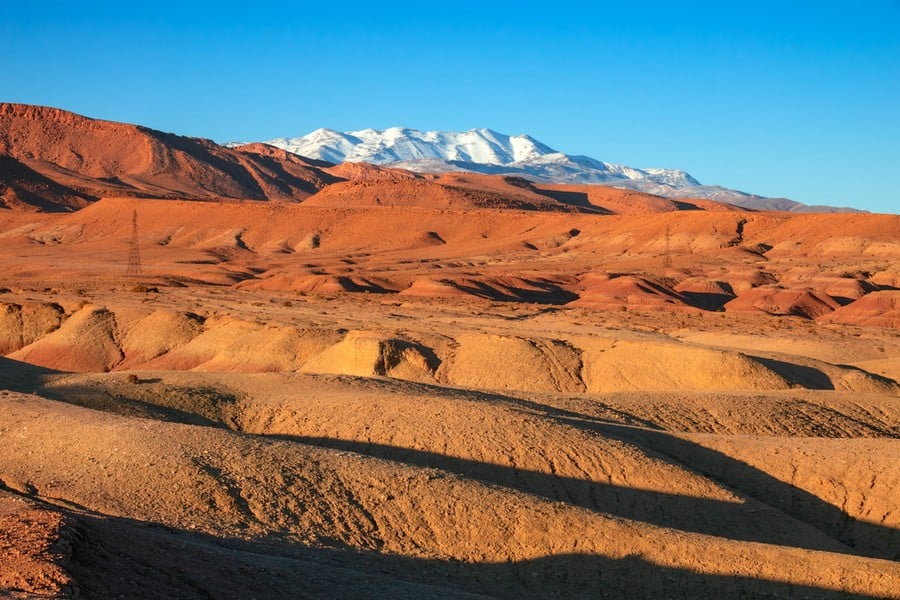
The Atlas Mountains vary in size and height. The highest peaks are located in the High Atlas range, inlcuding Mount Toubkal, the tallest mountain in North Africa (Mount Kilimanjaro, the tallest mountain in Africa, is located in Tanzania). The Atlas Mountains’ most notable peaks, from tallest to shortest, include:
- Mount Toubkal: 13,671 feet (4,167 meters) – highest peak in the Atlas Mountains and North Africa, located in the High Atlas range of Morocco.
- Mount M’Goun: 13,356 feet (4,071 meters) – also known as Jebel M’Goun, it is the second-highest peak in the Atlas Mountains, situated in the High Atlas range.
- Mount Ayachi: 12,260 feet (3,737 meters) – in the High Atlas range, offering stunning views of the surrounding landscape.
- Mount Ayyachi: 12,326 feet (3,757 meters) – in the High Atlas range, known for its challenging hiking trails and rugged terrain.
- Jebel Siroua: 10,840 feet (3,304 meters) – in the Anti-Atlas range, with distinctive cone shape and barren slopes.
- Jebel Tichka: 12,043 feet (3,671 meters) – in the High Atlas range, often traversed by travelers en route to the Sahara Desert.
- Mount Moulouya: 10,751 feet (3,278 meters) – in the Middle Atlas range, known for its diverse flora and fauna.
- Jebel Bou Naceur: 10,604 feet (3,232 meters) – in the Middle Atlas range, offering panoramic views of the surrounding countryside.
- Mount Chelia: 7,638 feet (2,328 meters) – in the Aurès Mountains of Algeria, renowned for its rugged beauty and scenic vistas.
- Jebel Chélia: 7,638 feet (2,328 meters) – in the Saharan Atlas range of Algeria, offering stunning views of the desert landscape.
What are the Some Famous Features of the Atlas Mountains?
Along with the lofty peaks, the Atlas Mountains boast awe-inspiring features. Among them include everything from cascading waterfalls and lush oases to ancient Berber villages clinging to the mountainsides.
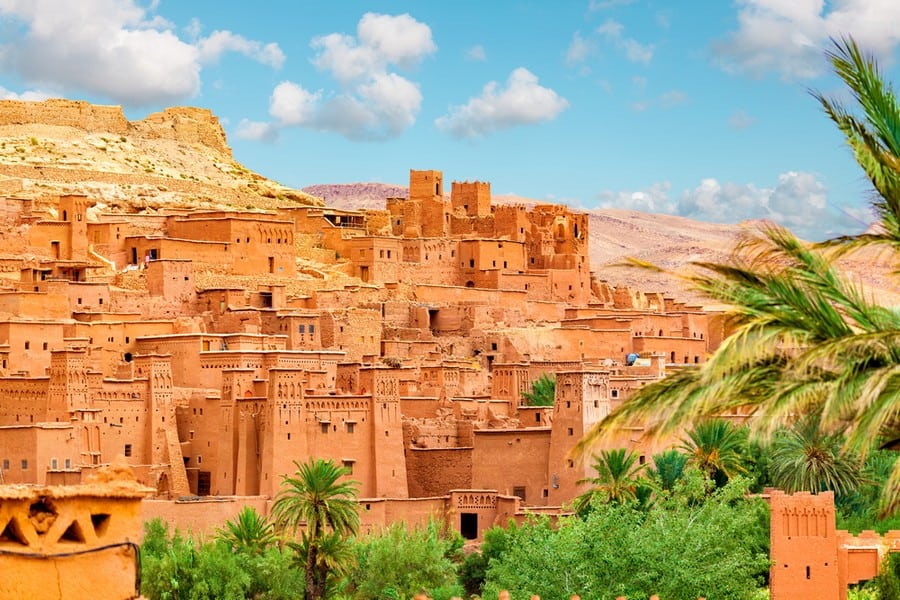
Here are some of the most notable attractions:
- Todra and Dades Gorges – dramatic cliffs and unbeatable views.
- Tizi n’Tichka Pass – a scenic route between Marrakech and the Sahara Desert.
- Atlas Cedar Forests – ancient forests with unique wildlife.
- Ait Benhaddou – a UNESCO site and fortified village.
- Ouzoud Waterfalls – the highest waterfalls in North Africa.
- M’Goun Massif – a rugged range known for its hiking trails.
What are Notable Hikes in the Atlas Mountains?
Avid hikers and outdoor lovers can find many trekking opportunities in the Atlas Mountains. The most popular is an ascent of Mount Toubkal, which promises to be a rewarding challenge. At the same time, the scenic trails of the High Atlas offer great vistas and encounters with local flora and fauna.

- Mount Toubkal – 2 days with 10-12 hours of hiking per day, reaching an elevation of 13,665 feet (4,167m); intermediate to advanced. Requires a good level of fitness and some prior trekking experience. Over two days, hikers will cover long distances with significant elevation gain, traversing rocky paths and steep ascents
- Berber Villages – 5 days, 5-7 hours walking per day, reaching an elevation of 8,202 feet (2500m); beginner to moderate. Offers a unique opportunity to explore the traditional Berber culture. Accommodation is typically in local guesthouses.
- Three Valleys Trek – 3 days, 5-7 hours per day, reaching an elevation of 8,202 feet (2500m); beginner to intermediate. Perfect introduction to the Atlas Mountains, suitable for those with limited time or less trekking experience.
- The Circle of Toubkal – 3 days, up to 12 hours of hiking per day, reaching an elevation of 13,665 feet (4,167m); intermediate to advanced. Demanding trek that takes hikers on a circular route around Mount Toubkal, requiring a good level of fitness and prior trekking experience.
What is the Weather Like in the Atlas Mountains?
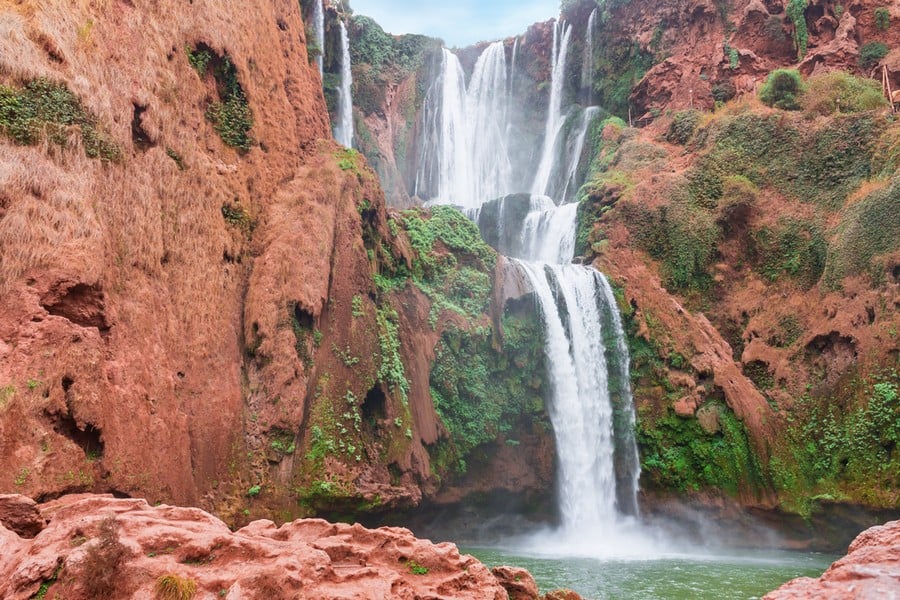
The climate in the Atlas Mountains varies depending on the region and altitude. Lower elevations experience a Mediterranean climate, characterized by mild, wet winters and hot, dry summers. As you ascend, the temperatures decrease, and the weather becomes more variable, with higher elevations experiencing cooler conditions year-round and significant snowfall during the winter months.
In spring (March to May), the Atlas Mountains begin to thaw from the winter chill, and the lower slopes are often covered in blooming wildflowers. Temperatures are generally mild, averaging between 59°F to 77°F (15°C to 25°C), making it an ideal time for hiking and outdoor activities. However, higher elevations can still have snow, and the weather can be unpredictable, with occasional rain showers.
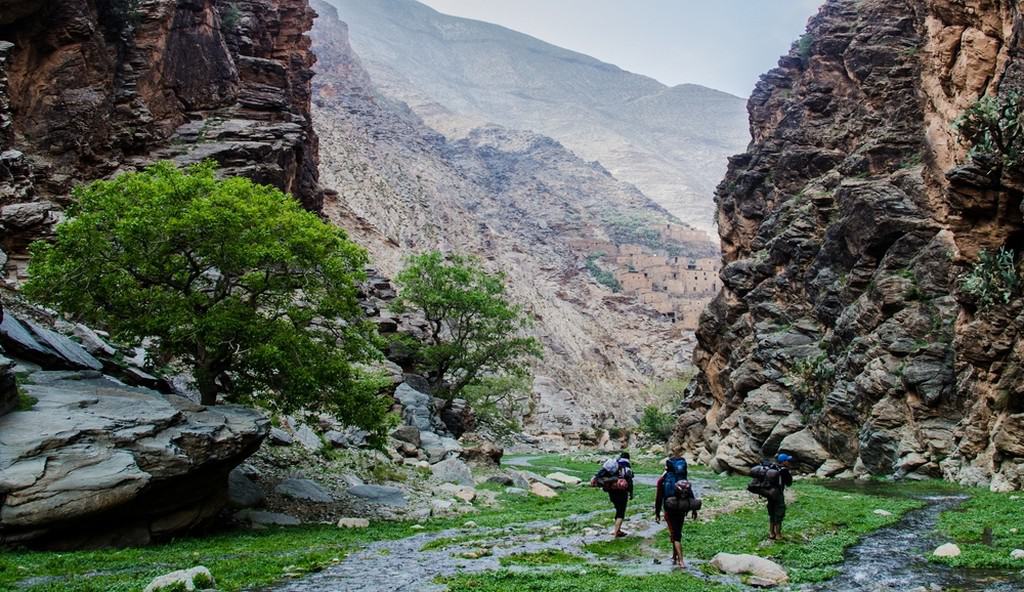
Summer (June to August) brings hot and dry conditions to the lower regions of the Atlas Mountains, with average highs ranging from 77°F to 95°F (25°C to 35°C) in the lower elevations. In contrast, the higher altitudes provide a cooler retreat, with daytime temperatures averaging around 68°F (20°C). This season is popular for trekking in the higher elevations to escape the intense heat of the lower plains. Summer is the driest season in the Atlas Mountains, with minimal rainfall and low humidity.
Autumn (September to November) sees a gradual cooling of temperatures, with average highs ranging from 59°F to 77°F (15°C to 25°C) in the lower elevations. Cooler temperatures prevail in the higher elevations, signaling the onset of winter. This season is another excellent time for hiking, as the weather is generally stable, and the landscape is lush from the summer rains.
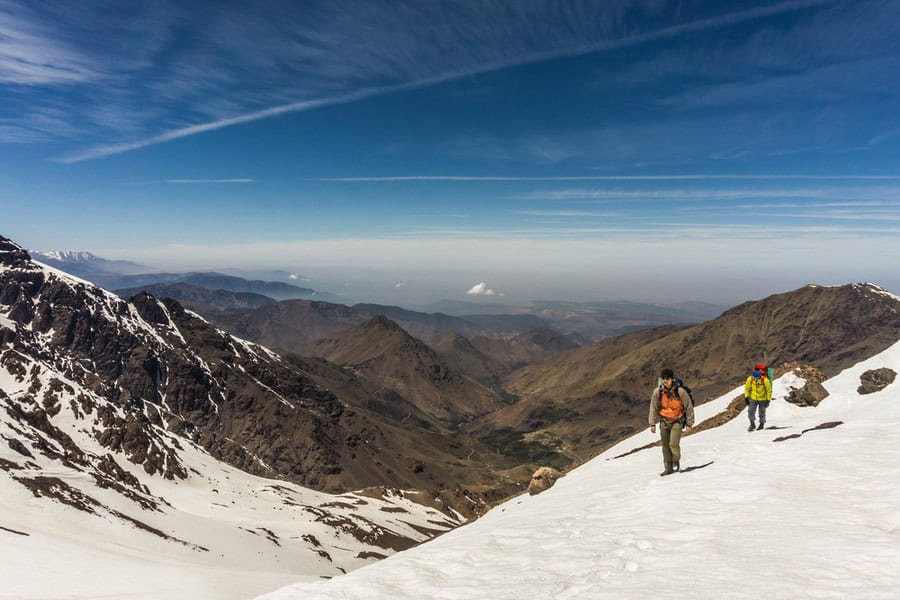
Winter (December to February) transforms the higher elevations of the Atlas Mountains into a snowy wonderland, particularly in the High Atlas range. Temperatures can drop below freezing, and snowfall is common. Daytime highs range from 32°F to 50°F (0°C to 10°C) in the lower elevations, while sub-zero temperatures are typical in the mountains.
When is the Best Time to Visit the Atlas Mountains?
The best time to visit the Atlas Mountains depends on the activities you wish to pursue and the type of weather you prefer. Generally, the most favorable times are during the spring and autumn months when the weather is mild.
- Best Overall: Spring (March to May) and Autumn (September to November) for mild temperatures, lush landscapes, and ideal hiking conditions.
- Summer (June to August): Great for high-altitude trekking and escaping the heat, but expect more tourists.
- Winter (December to February): Perfect for snow sports in the higher elevations, mild and wet in lower regions.
What Animals Are Found in the Atlas Mountains?

The Atlas Mountain ranges are a habitat for many animal species given its diverse range of habitats. The varying altitudes and climates within the range, from lush valleys to arid plateaus and snow-capped peaks, are a sanctuary for a vareity of endemic species.
Among the animals are the Barbary Macaque, the Barbary Leopard, the Atlas Deer, and the Barbary Stag. Resilient species like the Barbary Sheep and the solitary Atlas Mountain Badger navigate the steep slopes effortlessly. Other inhabitants include the Cuvier’s Gazelle, the North African Boar, Fennec Fox, and the Striped Hyena.
The higher altitudes of the Atlas Mountains provide a habitat for various birds of prey, including the golden eagle (Aquila chrysaetos) and the bearded vulture (Gypaetus barbatus). These birds are adapted to the cold, harsh conditions and have keen eyesight for spotting prey from great distances.

What Plant Life Can Be Found in the Atlas Mountains?
Overall, the plant life in the Atlas Mountains ranges from lush forests to arid desert vegetation.
Higher elevations feature extensive forests primarily composed of Atlas cedar, Holm oak, and cork oak. The lower slopes and valleys are dominated by shrublands and grasslands. The southern slopes and the Anti-Atlas support drought-resistant plants like the argan tree and various acacia species.
Rivers and streams in the Atlas Mountains sustain wetland and riparian zones, where oleander, poplar, and willow trees thrive.
Who Lived in the Atlas Mountains?
These mountains have been home to many civilizations. Legacies of traditions, architecture, and folklore exist here. From ancient kasbahs to bustling souks, the Atlas Mountains bear the marks of centuries of human history, embodying a mix of cultures.
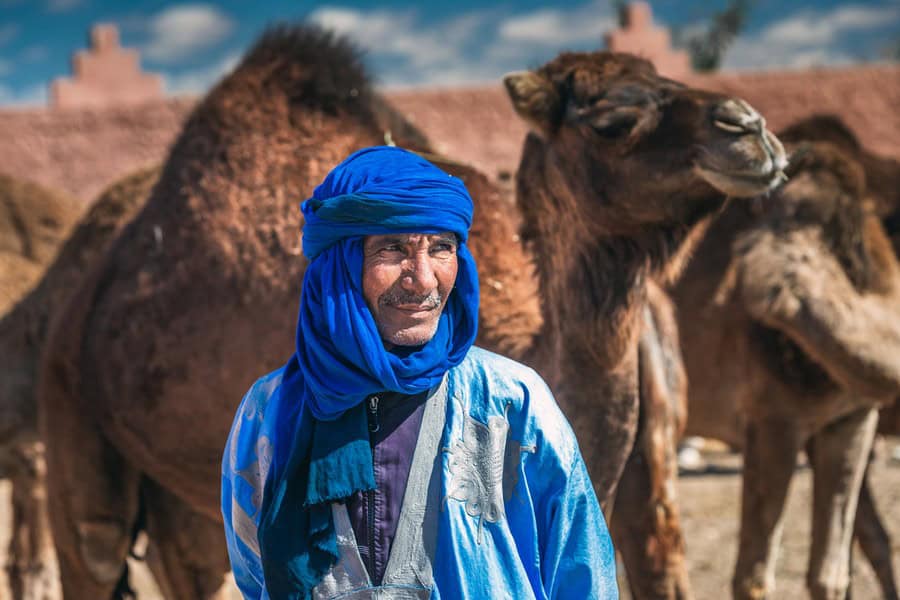
The most notable residents are the Berbers, whose presence is particularly prominent in the Atlas Mountains of Morocco and Algeria. The Berbers are the indigenous people of North Africa, with a history and culture that stretches back thousands of years. They have interacted with various civilizations over millennia, including the Phoenicians, Romans, Byzantines, Arabs, and Europeans, influencing and being influenced by these cultures.
Despite their interactions, the Berbers have maintained a strong sense of community and cultural cohesion. Berber society is traditionally organised into tribes or clans, each with its own leadership and social structure. Community and family ties are strong, with a focus on mutual support and cooperation. Today, the majority of Berbers are Sunni Muslims, although some communities have retained pre-Islamic practices and beliefs, blending them with Islamic traditions.





























































